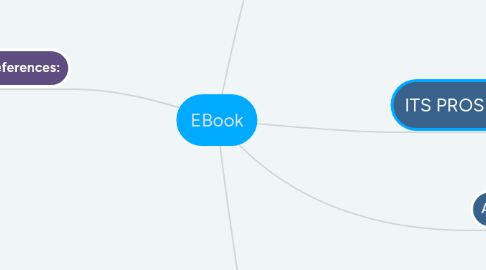
1. References:
1.1. "Advantages and disadvantages of reading via e-book"J. Manuel, 2020;Retrieved from:Advantages and disadvantages of reading via e-book
1.2. "Importance of eBooks in education"M.Harman, 2018; Retrieved from: Importance of eBooks in education - Kitaboo
1.3. "E-Books Are Damaging Your Health: Why We Should All Start Reading Paper Books Again"L. Bushak,2015; Retrieved from: E-Books Are Damaging Your Health: Why We Should All Start Reading Paper Books Again
2. AND
3. Face to Face Learning
3.1. PROS OF eBook in Face to Face Learning
3.1.1. Study Anywhere and Anytime:
3.1.2. An eBook is easy to carry around. Instead of carrying a bag full of books, it is easier to carry a mobile device that supports eBooks.
3.1.3. Environment Friendly and Saves Printing Costs :
3.1.4. eBooks do not require paper. Authors can submit their work in a PDF format, which can be converted into electronic books. Paper does not come into the picture. So, it saves all your printing related costs, right from purchasing printing paper, designing the layouts and hardcover etc. It even saves the environment by eliminating the need for printing.
3.1.5. eBooks are searchable:
3.1.6. You can easily search for any information in an eBook, instead of turning page after page. eBooks can show links, for easy access to more information and related websites.
3.1.7. eBooks take up less space:
3.1.8. You practically don’t need any space to store them. You don’t need a library or a room for them. You can store hundreds and thousands of eBooks on your computer or reading device.
3.2. CONS OF eBook in Face to Face Learning
3.2.1. Terrible pricing models:
3.2.2. Many publishers are using some pretty horrible pricing models for their ebooks. Many, for example, expect schools to pay individually for each copy of the ebook, requiring schools to purchase an ebook multiple times if they need to share it with multiple students simultaneously. Some publishers offer discounts on the books themselves, but many price the ebook at exactly the same as a regular print book.
3.2.3. Disturbance while reading:
3.2.4. You can be distracted by several apps, texts, games, phone calls of your device while reading any book. Hence, it is very irritating when you cannot give your full concentration on your reading. As a result, you can’t enjoy your reading which is not the case with printed copies of the book.
3.2.5. Incomplete feature list:
3.2.6. With a traditional paper book you can share it, annotate it, quote it, add comments, and add bookmarks. There are a lot of features which are not included in most ebooks at all. Given that websites allow for videos, simulations, games, and other interactivies to be included fairly easily, one wonders why most ebooks don’t include these features.
4. Asynchronous Learning
4.1. PROS OF eBook in Asynchronous Learning
4.1.1. Offline Access to eBooks:
4.1.2. Over 50% of the world’s population has access to the Internet. Yet we all sometimes have trouble with connectivity and network issues. In order to ensure that the Internet connection does not hamper the learning process mobile devices, these days, offer offline services. Students can now download any content they want and save it on their device and go through them later at their convenience.
4.1.3. Edutainment Value:
4.1.4. The course content doesn’t have to be only text. You can include music, animations, videos and audio explanations into the learning module. Videos make the learning process more interesting. Students can pause and rewind the video and watch it again. Animations are fun and entertaining and have more retention value.
4.1.5. Provide Updated Content to Students:
4.1.6. In traditional paperback books, if there’s some updated information that needs to be included in the syllabus, you’d probably have to reprint new books. But with eBooks, all the learning material is stored on the cloud. This means, eBooks can be updated anytime you want, and it will be reflected in all eBooks. So, you can always ensure that your students have up-to-date information with them at all times. This again saves your reprinting costs.
4.1.7. Interactive Assessments:
4.1.8. eBooks include self-assessments for students to test their knowledge. It does away with the traditional style of giving a quiz at the end of the chapter. eBooks are embedded with quizzes and exercises throughout the chapter and also after the chapter ends, to ensure that students retain the information that they are reading.
4.2. CONS OF eBook In Asynchronous Learning
4.2.1. E-Books Get In The Way Of Sleepytime:
4.2.2. A recent study out of Harvard University found that reading an e-book before bed lessened the production of an important sleep hormone known as melatonin. As a result, people took much longer to fall asleep, experienced less deep sleep, and were more fatigued in the morning.
4.2.3. Risk of losing books anytime:
4.2.4. If you don’t have any backup of your device then you can lose all the saved eBooks at any moment because of virus or hardware failure. Sometimes due to viruses or other problems, the eBooks can be deleted automatically at one shot from your mobile and that can become very hard to get recovered.
4.2.5. Harmful for health
4.2.6. The main disadvantages of reading eBooks is harmful for health. Sitting in front of your mobile or screen for hours might be very harmful for your health and body. It can contribute to weight gain, muscle pain, headache, neck pain, impaired sleep, backache, anxiety, and many more.

